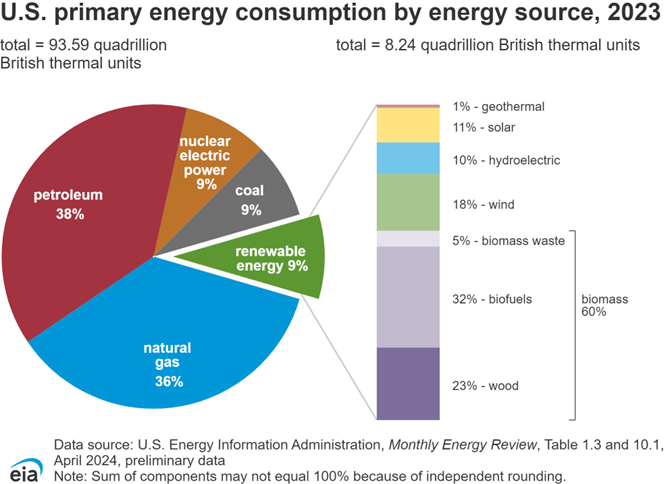According to a new report from the International Energy Agency (IEA), global electricity demand is expected to rise sharply in 2024 and 2025. IEA attributes the rise due to robust economic growth, intense heatwaves, and increasing use of technologies that run on electricity such as electric vehicles (EVs) and heat pumps. The report predicts electricity demand will increase by 3% year-on-year. This increase in electricity consumption is likely due to an improved economic outlook, rising demand for air conditioning amid severe heat waves, and the surge in data center expansions.

Communities in cities, towns, and rural areas across the globe rely on large, centralized power plants for their energy needs. Unfortunately, centralized power plants are typically powered by fossil fuels like coal, oil, or natural gas. Fossil fuel-based power plants emit significant quantities of greenhouse gases (GHGs) contributing to global warming, along with other pollutants that harm air quality. Plants powered by nuclear energy may be low-carbon, but lead to concerns about radiation and the disposal of nuclear waste.
Generating power in plants results in energy loss due to being transported over long distances through transmission and distribution (T&D) lines. Any failure at these power plants or along transmission lines can potentially disrupt power supply. According to the US Energy Information Administration (EIA), US electricity customers experienced an average of 8 hours of electric power interruptions in 2020. This outage time is the most since the administration began collecting electricity reliability data in 2013.
Distributed Energy Resources
Due to increased energy demand, companies and communities are turning to distributed energy resources (DERs) to address energy concerns. This technology reduces energy costs by generating power on site, reducing reliance on the grid, and associated T&D costs. In addition, DERs provide energy independence, which mitigates the risks associated with power outages or price fluctuations. Those using renewable sources, like solar and wind, significantly reduce GHG emissions and improve sustainability. DERs also provide backup power during grid outages, which ensures that critical operations continue uninterrupted. For companies looking to optimize their energy usage and reduce demand charges, DERs offer greater control over energy consumption and production. Technological advancements have made DERs more affordable, resulting in the ability to easily integrate into existing energy systems.
DERs, small-scale energy resources used to generate, store, and control electricity locally, are often located near where electricity is used, such as on rooftops or buildings. They are usually connected to a centralized or isolated power grid. DERs include renewable energy technologies, storage devices, and other appliances that interact with the grid, such as solar panels, wind turbines, batteries, biogas, and others. Those companies aiming to reduce carbon footprints, lower traditional energy dependence, save operating costs, and improve operational reliability, DER technology can help them reach their goals.
Google is employing DER technology in order to save money on energy usage, increase power reliability, and invest in sustainability. Google has invested over $1 billion in wind and solar power plants, and has signed agreements to buy power from renewable energy projects. In addition, Google plans to install a battery-based system for backup power at one of its data centers. The goal is to operate on 24/7 carbon-free energy by 2030. To achieve this, Google is working with carbon-free energy sources like solar and wind.
Types of Distributed Energy Resources
Microgrids
A microgrid is a localized energy system capable of operating independently or in conjunction with the main power grid. These systems typically incorporate a mix of DERs, such as renewable energy sources, energy storage, and advanced control systems. By generating electricity closer to the point of consumption, microgrids often leverage renewable options like solar, wind, or hydro power. A key advantage is their ability to operate autonomously during grid outages, ensuring uninterrupted power supply. Additionally, microgrids facilitate efficient integration of renewable energy by incorporating energy storage solutions to manage fluctuations in energy demand.
Microgrids play a pivotal role in the transition to a more sustainable energy future. By maximizing local renewable resources and minimizing energy losses during transmission, microgrids contribute to the widespread adoption of clean energy technologies. Furthermore, they empower communities by providing greater control over their energy supply, potentially leading to cost reductions and economic growth. Microgrids can also serve as experimental platforms for innovative energy technologies and practices. Several microgrid examples:
- Universities: Due to high energy demands from sprawling campuses, implementing a microgrid allows universities to optimize their energy management and enhance sustainability. Princeton University has developed a microgrid that integrates solar panels, cogeneration, and energy storage. This enables the university to generate clean electricity, reduce carbon emissions, and provide backup power during outages.
- Hospitals and Healthcare Facilities: These institutions depend on a constant and dependable energy source to maintain patient care and essential functions. Microgrids provide these facilities with energy security and autonomy from the main power grid. Kaiser Permanente Hospital in Richmond, California has implemented a microgrid system that combines solar energy, battery storage, and sophisticated control mechanisms. This enables the hospital to function independently during crises and cut down on operational expenses by efficiently managing its energy consumption.
Distributed Energy Generation
Distributed energy generation (DEG) is the production of electricity near the point of consumption rather than relying solely on large, centralized power plants. This type of generation can power an individual building, like a home or business, or be integrated into a microgrid. It can serve locations like industrial facilities, military bases, or large college campuses. Connecting distributed generation systems to an electric utility’s low-voltage distribution network enhances the delivery of clean and reliable power to a broader customer base while reducing transmission and distribution line losses.
There are many benefits to distributed power generation including:
- Increased efficiency: Generating electricity closer to consumers reduces energy losses during transmission.
- Environmental impact reduction: Carbon emissions can be decreased by utilizing renewable sources and generating electricity locally.
- Enhanced grid reliability: DERs can provide backup power during outages and help stabilize the grid.
- Cost savings: Consumers can potentially reduce electricity bills and even earn income by selling excess power back to the grid.
While challenges exist, the growing adoption of decentralized power production is reshaping the energy landscape and contributing to a more sustainable and resilient future.
- Brighter Future Solar project: Will generate and send 19,000 megawatt hours (MWh) of carbon-free electricity into the grid annually. The locally generated electricity can offset some of the need for extra power to be bought in from a traditional electricity provider at times of peak demand, when wholesale power costs are highest. The project developer, Oriden, is backed by Mitsubishi Power Americas, a Mitsubishi Heavy Industries (MHI) Group company.
Onsite Energy Storage
Onsite energy storage refers to the technology that allows local generation and storage of energy directly, rather than relying solely on the grid. This typically involves using renewable energy sources like solar or wind power and storing the excess electricity produced for later use. The stored energy can be used when the grid power is unavailable, expensive, or when renewable energy production is low.

Onsite energy storage offers several advantages. It can lead to cost savings by decreasing dependence on the electrical grid, potentially resulting in lower utility bills. In addition, it can serve as a backup power source during grid outages. In addition, onsite storage can reduce carbon footprint when paired with renewable energy sources. Finally, it enables effective peak demand management which allows for better control of energy consumption during high-usage periods.
Common onsite energy storage technologies include:
- Batteries: Lithium ion (Li-ion) batteries are the most common for storing electricity, although other battery chemistries may be utilized as well
- Thermal Storage: Stores heat or cold for later use, often used with solar thermal systems
- Flywheels: Store energy in the form of rotational kinetic energy
Onsite energy storage applications include solar panels with battery backup for homes, battery storage for businesses to reduce energy costs and improve reliability, large-scale battery systems for factories and manufacturing plants, and energy storage systems connected to the grid to balance supply and demand.
Energy Advancements
Technologies, such as microgrids and smart grids, improve grid reliability and efficiency through localized and AI-driven energy management. Additional technologies such as blockchain enable secure peer-to-peer (P2P) energy trading, while virtual power plants (VPPs) collect distributed resources to stabilize the grid. Energy-as-a-service (EaaS) models will offer subscription-based, customized energy solutions, further enhancing DER adoption.
These trends and innovations are driving the transition to a more decentralized, sustainable, and resilient energy future. As DERs continue to evolve, they will play a crucial role in addressing the challenges of climate change, energy security, and grid modernization.


